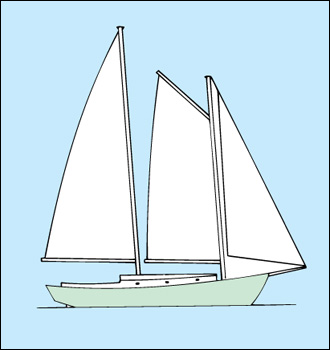Schooner is a sailing vessel with two or more masts (upright poles) and sails arranged in a layout called fore-and-aft rigging. In such a layout, the sails run along—rather than across—the line of the ship’s hull (body). Merchants, smugglers, and slave traders often sailed schooners during the 1700’s and 1800’s. The vessels required relatively few crew members to operate.

The first American ship with such a design is thought to have been launched in Gloucester, Massachusetts, in 1713. It impressed spectators with the way it glided over the water. The ship’s maker came up with the name schooner after a spectator remarked, “How she scoons (skims).” Because of its ease of operation, the schooner became popular among New England’s traders and fishing crews during the 1700’s.
In the early 1800’s, shipbuilders developed a narrow, many-sailed type of schooner called the Baltimore clipper. Baltimore clippers had raked (angled) masts that increased the vessel’s speed and handling. Local sailors used the fast, maneuverable ships to guide larger merchant ships safely into ports. During the War of 1812, Baltimore clippers served as cargo vessels. Armed Baltimore clippers were also used by _privateers—_private crews authorized by governments—to attack merchant ships from other countries.
Smugglers and slave traders, favoring speed over carrying capacity, also used schooners. In 1839, a Spanish slaving schooner called the Amistad drew worldwide attention when its slaves rebelled and sailed the ship to the United States. Schooners also saw wide use as racing vessels.
Over time, shipbuilders made larger schooners with more masts. The largest pure sailing ship ever built, the Thomas W. Lawson, was a seven-masted schooner made in 1902.
See also Amistad Rebellion ; Bluenose ; Clipper ship ; Sailing (Yawls, ketches, and schooners) .
